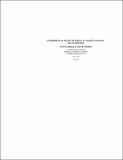| dc.contributor.author | Johnson, Eric N. | |
| dc.contributor.author | Pritchett, Amy R. | |
| dc.date.accessioned | 2007-02-16T21:33:17Z | |
| dc.date.available | 2007-02-16T21:33:17Z | |
| dc.date.issued | 1995-03 | |
| dc.identifier.uri | http://hdl.handle.net/1721.1/35913 | |
| dc.description.abstract | An experimental simulator study was run to test pilot detection of an error in autopilot mode selection. Active airline air crew were asked to fly landing approaches by commanding the Flight Path Angle mode while monitoring the approach with both a Head Up Display and Head Down Displays. During one approach, the Vertical Speed mode was intentionally triggered by an experimenter instead, causing a high rate of descent below the intended glide path. Of the 12 pilots, 10 were unable to detect the high descent rate prior to significant glide path deviation. | en |
| dc.language.iso | en_US | en |
| dc.publisher | International Center for Air Transportation | en |
| dc.relation.ispartofseries | ASL-95-3 | en |
| dc.subject | autopilot | en |
| dc.subject | Flight Path Angle | en |
| dc.subject | Head Up Display | en |
| dc.subject | Head Down Displays | en |
| dc.subject | human factors | en |
| dc.subject | air transportation | en |
| dc.title | Experimental Study of Vertical Flight Path Mode Awareness | en |
| dc.type | Technical Report | en |
